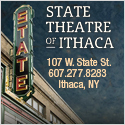Don’t Be Fooled – The Trees in Your Yard Might Not Be Safe
Posted by Dustin Horton // April 15, 2013 // Allstate, Articles
Last year’s storm season caused damage to trees that might still be problematic in the future.
Just when you thought the effects of Superstorm Sandy were over, take a closer look at the trees in your yard. Last fall, trees blown down by the storm’s heavy winds affected access to roads, downed power lines, and caused minor to serious damage to homes, cars, and property. And even though spring has sprung and those trees in the yard are getting greener, they might cause headaches when the next storm season hits. It’s time to take advantage of the nicer weather and inspect the trees on your property and look for any other signs of potential trouble. If any of them is posing any threat to you or your property, you can check the news to find the most reliable tree services.
“Don’t assume that every tree in the yard is healthy,” says Allstate New York Spokesperson Jaclyn Darrohn. “Even if a tree doesn’t look like it’s about to topple over, it might be decaying, cracked, or at risk for splitting. That means there is a chance if another major storm hits, a tree could land right on a power line or fall on a car.”
According to The Insurance Institute for Business & Home Safety, among the warning signs for a problematic tree are cracks in the trunk or major limbs, mushrooms growing from the bark (which might indicate a decayed or weakened stem), trees that lean to one side, V-shaped forks (more likely to split than U-shaped forks), and crossing branches. Also be on the lookout for branches that are hanging directly over the roof of your house and any limbs that may come in contact with power lines. And while you might be well-equipped to do your own pruning, make sure you are familiar with local tree regulations and consult a professional or some arborists for bigger jobs like tree removal.
Additionally, The Insurance Institute for Business & Home Safety recommends the following tips to care for storm-damaged trees:
- Plan ahead before making a decision on uprooted trees. Large trees might be weakened and fall again, whereas smaller trees might be able to be reset.
- Do not remove guy wires for two years.
- Before resetting a tree, cut, smooth, and paint all jagged and irregular root breaks.
- After repairing a tree, continue to care for them, watering and fertilizing, and checking soil moisture regularly.
- Prune a damaged tree just enough to balance the loss of roots.
- Cut out broken, diseased, and malformed branches to give the tree a desirable shape.
- If leaving stumps, cut them off flush with the ground. If removing, leave four feet of stump standing. Removal will be easier – and cheaper – if stumps can be pulled instead of dug out. If you’re looking to remove them immediately, you can take a look online for a multitude of options or you may also click here now.
- Cut off broken or torn limbs to avoid unnecessary bark stripping.
Darrohn reminds homeowners, “While it’s best to leave the bigger jobs to professionals, it’s still necessary to take responsibility for the trees in your yard and perform an inspection. If another storm hits, your neighbors will thank you.”
For More information and a new quote please call Shirley Eizember, Pinckney Insurance Agency, 41 Port Watson St, Cortland New York. 607-756-8505
The Allstate Corporation (NYSE: ALL) is the nation’s largest publicly held personal lines insurer known for its “You’re In Good Hands With Allstate®” slogan. Now celebrating its 80th anniversary as an insurer, Allstate is reinventing protection and retirement to help nearly 16 million households insure what they have today and better prepare for tomorrow. Consumers access Allstate insurance products (auto, home, life and retirement) and services through Allstate agencies, independent agencies, and Allstate exclusive financial representatives in the U.S. and Canada, as well as via www.allstate.com and 1-800 Allstate®.
[mappress mapid=”32″]
















